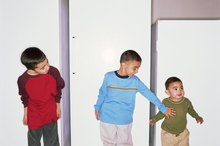How to Stop Your Child From Teasing or Hurting the Dog
Most children naturally want to interact with the family dog, but to avoid possible injury to the dog or bites to your child, it is essential that they learn how to safely interact with the dog. According to the American Humane Association, approximately 4.7 million dog bites occur each year in the United States, with over 50 percent of those bites involving children under the age of 12. Teaching your child how to play appropriately with dogs helps to reduce the risk of injury to both your child and the dog.
Appeal to your child’s sense of empathy. Ask her how she thinks the dog feels when she pulls his tail. Ask her how she would feel if someone pulled her hair. Explain that hurting or teasing the dog makes him feel sad or scared and that when he is scared, he may bite and hurt her.
Clavamox Drops Side Effects
Learn More
Teach your child how to read a dog’s behavior. Explain that when a dog growls, barks, raises the hair on his back, stiffens up his body or pulls his ears forward or backward, he is not happy and does not want to play. If your child is teasing or hitting Fido when this behavior happens, explain that they are hurting the dog and he does not want to play that way. Explain that when he wags his tail and is bouncing around, he is having fun and wants to play.
Play with your dog and child together, showing your child the appropriate way to play. Plan regular “dog playtime” where together you play fetch or other games with your dog. If, during this playtime, inappropriate teasing or hurting occurs, exclude your child from the activity. Explain that if they can’t play nice, they can’t play at all. Continue to play with the dog for the regular amount of time, leaving your child to miss the activities. Let them know they can play during the next “playtime,” if they play nicely.
Food Sensitivities and Ringing in Ears
Learn More
Take treats or snacks away from your child. If your child is teasing the dog with their snacks or other food, take the snacks away. If it is a dog-safe food, give it to the dog 1. If not, throw the food away and give the dog one of his treats. Let your child know it is not nice to tempt the dog with food they are not going to give him and that they will lose their treats if it happens.
Warnings
If teasing and dangerous behavior toward the dog continue despite your efforts, or it appears your child is intentionally trying to hurt the dog, it may be sign of an underlying emotional problem. Discuss the behavior with your child’s pediatrician.
Related Articles
References
- Healthychildren.org: Safety Around Animals
- Freeman S, et al. Parent-child interactions in autism: characteristics of play. Autism. 2013 Mar;17(2):147-61. doi:10.1177/1362361312469269
- Strid K, et al. Pretend play, deferred imitation and parent-child interaction in speaking and non-speaking children with autism. Scand J Psychol. 2013 Feb;54(1):26-32. doi:10.1111/sjop.12003
Warnings
- If teasing and dangerous behavior toward the dog continue despite your efforts, or it appears your child is intentionally trying to hurt the dog, it may be sign of an underlying emotional problem. Discuss the behavior with your child’s pediatrician.
Writer Bio
Deborah Lundin is a professional writer with more than 20 years of experience in the medical field and as a small business owner. She studied medical science and sociology at Northern Illinois University. Her passions and interests include fitness, health, healthy eating, children and pets.









